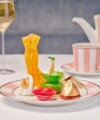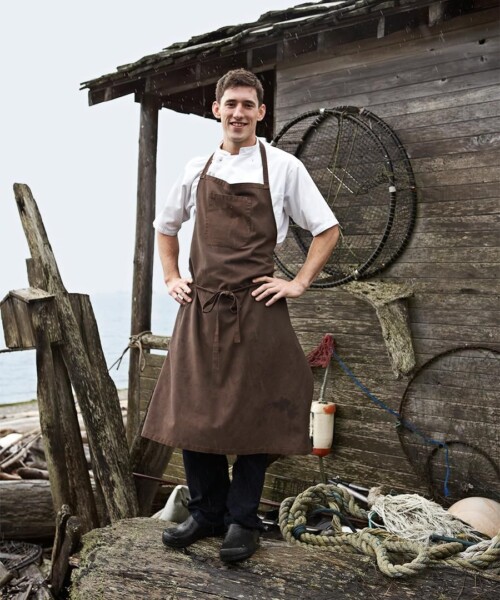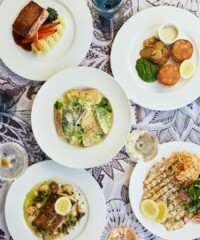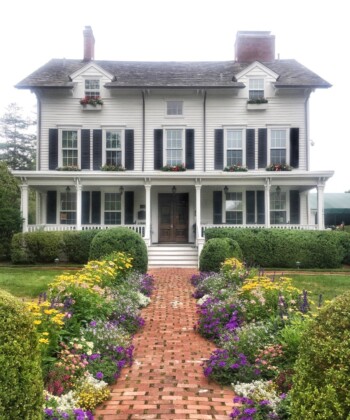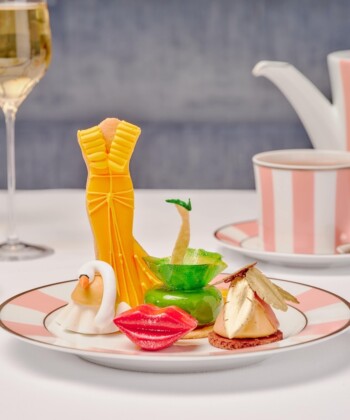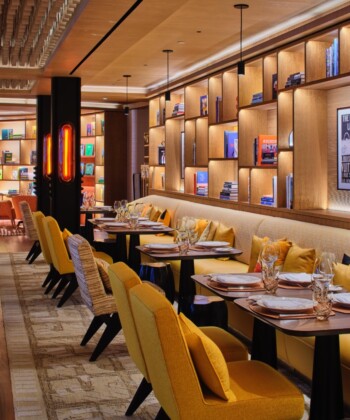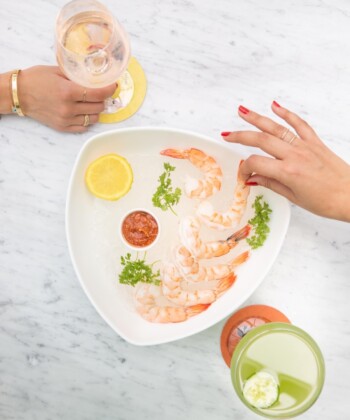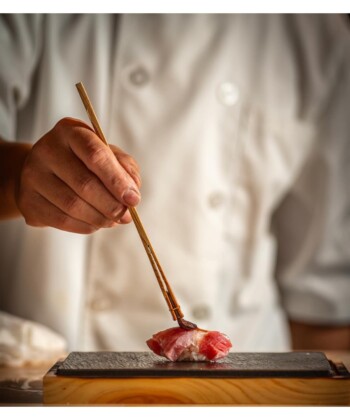Behind every great dish is a chattering of stories waiting to be told. Take the ripe blackberries with wild yarrow, carrot flowers, sorrel and chickweed in a puddle of dill oil that are served at the Willows Inn on Washington’s Lummi Island. One tale you might tell could be of its ingredients: how the berries were foraged only a few hours earlier from bushes plump with fruit, the yarrow and chickweed plucked from a field of the farm up the hill from the restaurant. Or, you could talk about the person behind the culinary creation: Blaine Wetzel, the Inn’s inventive 26-year-old chef who, after answering a Craiglist ad, took over the Willows’ kitchen and transformed a struggling restaurant into an international dining destination.
Still, you might just take a spoonful of the tart fruit and the grassy greens, put it in your mouth and experience what life tastes like on this patch of an island in the Pacific Northwest on a sunny, warm, mid-September day. That’s exactly the kind of storytelling that Wetzel is trying to accomplish with his cooking. “I want each dish to reflect a moment in time and nature,” he says.
Wetzel has succeeded in that mission—and the epicurean world agrees. This year, Food & Wine magazine named him one of its 10 Best New Chefs, and the New York Times included the Willows Inn on its list of “10 Restaurants Worth a Plane Ride.” However, getting to Lummi Island is actually not that simple—after flying to Seattle, you’ll need to drive for two hours and then take a six-minute ferry ride to this smallest of the San Juan Islands. The island itself is only nine square miles, half of it a forested nature preserve, with a population of 964. Besides the Willows Inn, it contains one café and one general store.
Why has so much attention been paid to someone working in such an off-the-beaten-track part of the U.S.? His resume—or one particular entry on it. Before the Willows, Wetzel served as a chef in the kitchen of Noma in Copenhagen, crowned the World’s Best Restaurant by sponsors San Pellegrino and Acqua Panna for two years. (Wetzel has plenty of other restaurant experience: He’s also worked at the Phoenician Resort in Scottsdale, Arizona; Citronelle in Carmel, California; and Alex in Las Vegas.) Noma executive chef Rene Redzepi has been hailed for reinventing Nordic cuisine by using local, often wild, products in surprising ways. Signature dishes include radishes in a flowerpot filled with a soil made from malt and hazelnuts; an oyster steamed in sea water and placed in the shell atop chilled beach pebbles; and white asparagus and spruce sauce. Many of the ingredients have been foraged by Redzepi and his chefs from the nearby shore and forests.
And Wetzel has carried that unique practice over to the Willows Inn. As a result, it’s probably only on Lummi Island that one can drive around and espy the odd sight of a professional chef—one of the restaurant’s staff, dressed in kitchen whites—scavenging berries in a patch at the side of the road. Redzepi’s methods immediately resonated with Wetzel. The soft-spoken chef says, “Growing up in the Northwest [he’s from Olympia, WA] I’ve been going mushroom hunting since I was young. I was outside a lot, collecting blackberries and other things.” He adds, “Before Noma, I thought foraging was something you did at home; I don’t know it could be applicable on a larger scale.” But in Copenhagen, he saw 80 diners a day consuming wild herbs, vegetables and fruits—and loving them.
The six chefs working in the Willows’ kitchen forage every day; Wetzel tries to go just about as often and usually in the mornings. Watching him in action is not unlike watching a shopper go through a grocery store and pick out stuff. Here, instead of trolling the aisles, he’s got the entire outdoors as an open-air market. Wetzel starts with an ingredient he needs—like chickweed, a spinach-like weed—in mind. Then, he heads to spots on Lummi Island where it grows—striding through a field behind the inn or scrambling up a sandy bank near the beach—to gather enough for his diners that evening. But a foraging chef must multi-task as well: While he’s prowling, he’s also checking out the surrounding plant life to forecast when it will be ready—to see how the salmonberries are coming along or whether the hips on the wild beach roses are big enough to pick. “I can be inspired by where an ingredient grows,” he says. So the grasses and herbs peeking out from beneath the wild blackberry bushes led to the berry dish described earlier.
Besides foraging, Wetzel has many other food sources. There’s a four-acre farm up the hill that’s leased by the Inn and staffed by two full-time farmers which grows anything and supplies an endless amount of free-range chicken eggs. The Innalso has access to two full-time fishing boats that employ the reef-net technique invented by native Americans to catch the local salmon—a spotter stands on a tower on the boat’s deck, sees a school of incoming fish; and tells the crew who lower a huge net into the water and scoop them up. In his cooking, Wetzel will only use ingredients from his area—that means no citrus and no olive oil.
But when you dine at the Willows, I promise you won’t miss either of these. Right now dinner is the only meal served at the Willows, and at three hours, it’s a movie-length affair, complete with dramatic crescendos and surprise cameos. Guests are told to arrive by 6:30, and parties are seated gradually and in staggered groups, timed in the late summer and early fall so that people will be in place to enjoy the stunning Puget Sound sunset. Soon a server brings a first course to the table, setting down a plain, square, palm-sized cedar box. When you lift the cover, intriguing wisps of smoke drift up. Inside is a thumb-length, brown tuber, nestled on a bed of moss and tea leaves. It’s a baked sunflower root, and it’s the sweetest and most succulent one—well, the only one—you’ve ever had. But as delightful as eating it is the experience of watching diners around the room marvel and mumur over their own boxes with wonder-filled, child-like faces.
“When you eat at the Willows, you find yourself so captivated with what you’re seeing, smelling and tasting that you want to talk about it with your friends,” says John Gibb, managing partner of the inn. “I’ve been out to dinner lots of times where I’ve said, ‘Boy, this is a good steak’ or ‘I really like these vegetables,’ but never in the way I was at the Willows, where I was completely enthralled and just wanted to have a conversation about the food.”
The meal is a succession of 16 small courses—some are as petite as one pickled bay oyster with tapioca pearls nestled underneath (and, in a nod to Noma, the shell on icy beach stones) or a potato chip-like crispy halibut skin dabbed with wild razor clams and a halibut emulsion. The largest dishes are just five bites big, like a slender slice of dried smoked venison bedizened with a crispy mix ofbread crumbs and chopped bits of foraged cress, chanterelles and berries. Everything tastes pure, clean and distinctive, just like the island itself.
Gibb believes that Wetzel is on the verge of becoming a celebrity chef, not in the Guy Fieri or Paula Deen way but like a Rene Redzepi or Ferran Adria, a figure who influences how we cook and what we eat on a global scale. Surprisingly, the low-key Wetzel himself welcomes success—not because as a means to fame but as a license for him to keep exploring, in the kitchen and outdoors. “It won’t change what I do,” he says. “It just encourages do more, to follow my vision more thoroughly.” Wherever he goes, the journey is sure to be wild.








